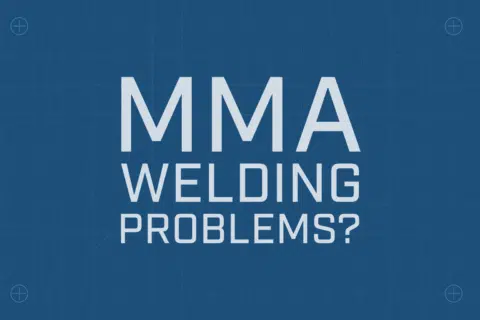Manual Metal Arc (MMA) welding — also called Shielded Metal Arc Welding (SMAW) — is a versatile process used in fabrication, construction, and repair. Weld quality is critical: defects reduce strength, integrity, and service life.
This guide outlines the most common MMA weld quality issues and practical ways to prevent them.
Quick Reference: MMA Weld Defects & Prevention
| Defect | Description | Main Causes | Prevention |
|---|---|---|---|
| Spatter | Molten droplets around weld, affects appearance, adds cleaning time | High current, long arc, arc blow | Correct current, short arc, control arc blow, use anti-spatter spray |
| Porosity | Gas pockets/voids inside weld, weakens structure | Contaminated joints, high speed, long arc, moisture/hydrogen | Clean joints, use low-hydrogen electrodes, correct speed/arc length |
| Poor Fusion | Base metal & filler don’t bond fully | Low heat input, bad arc length, poor joint prep | Set proper current, prep joints, hold correct angle |
| Shallow Penetration | Weld too shallow, weak joint | Low current, long arc, wrong travel speed/angle | Increase current, shorten arc, slow travel, improve joint design |
| Cracking | Cracks in weld or HAZ, risk of failure | Hydrogen, rapid cooling, high residual stress | Preheat/slow cooling, use low-hydrogen rods, stress relief heat treatment |
Defects Explained & How to Prevent Them
1. Weld Spatter
- Impact: Doesn’t weaken weld but looks poor, increases cleanup and finishing costs.
- Causes: Too much current, long arc, arc blow.
- Prevention:
- Set current within electrode range.
- Keep arc short and stable.
- Use backhand (drag) technique.
- Apply anti-spatter spray before welding.
2. Porosity
- Impact: Gas pockets reduce strength, ductility, and fatigue resistance.
- Causes: Dirty joints, fast travel speed, long arc, hydrogen from damp rods.
- Prevention:
- Thoroughly clean base metal (oil, rust, moisture).
- Maintain steady, moderate travel speed.
- Arc length ~2–4mm.
- Use low-hydrogen electrodes and store them dry.
3. Poor Fusion
- Impact: Weak bond → risk of failure, leaks, cracks.
- Causes: Low heat input, wrong angle, poor joint prep.
- Prevention:
- Correct current and arc length.
- Prep surfaces (grind/brush/clean).
- Maintain proper electrode angle (~10–15° drag).
- Ensure correct fit-up.
4. Shallow Penetration
- Impact: Weak joints, stress points, reduced fatigue and corrosion resistance.
- Causes: Low current, long arc, fast travel, poor joint design.
- Prevention:
- Increase current within limits.
- Use shorter arc.
- Slow travel slightly.
- Improve joint design (V/U groove, correct gap).
5. Cracking
- Impact: Serious — cracks can cause catastrophic failure.
- Types:
- Hot cracks (during cooling).
- Cold cracks (hydrogen-induced, appear later).
- Stress cracks (from residual stress).
- Causes: Hydrogen in weld, rapid cooling, residual stress.
- Prevention:
- Preheat where needed; control interpass temp.
- Use low-hydrogen rods.
- Stress relieve / post-weld heat treat when required.
- Proper joint prep & welding sequence.
Key Takeaway
MMA weld defects can be minimized by:
- Correct settings (current, arc length, travel speed).
- Clean joints and proper prep.
- Using low-hydrogen electrodes.
- Managing cooling and stress.
Shop MMA Welders & Consumables
Explore our full range of MMA welders and electrodes, designed for consistent performance and fewer quality issues.




